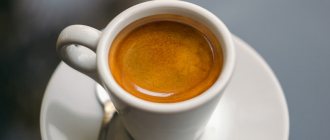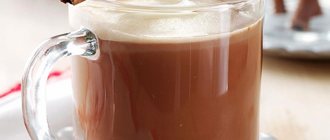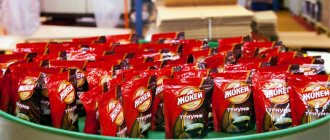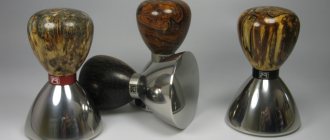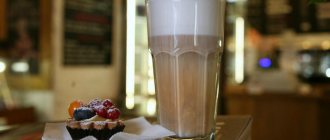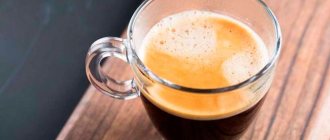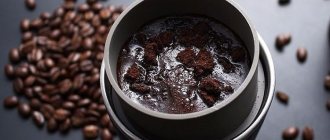Doppio is translated from Italian as “double”. With all the advantages of espresso, for most coffee drinkers, two sips are not enough to enjoy it. Since there have always been a large number of similar coffee drinkers, the term doppio espresso was gradually replaced by the abbreviated doppio. Now double espresso is considered to be an independent type, separately prescribed in the establishment’s menu.
Differences between doppio and other varieties
Doppio is a double shot of espresso poured into one cup. The only difference from a shot is the volume of the drink and double the amount of caffeine, the concentration of the latter corresponds to that in a standard serving of espresso.
If we compare the volumes, they correspond to lungo. But to double the portion, you need to use coarsely ground coffee beans or double the extraction time. Double and traditional are brewed from beans of the same degree of grinding.
Americano is a variety of black coffee that is served in large portions, but is essentially espresso diluted with water.
Differences between doppio coffee and other drinks
A serving of espresso is calculated differently around the world. So Italian baristas serve their customers coffee in a volume of 30-45 ml, in European countries the volume of the drink is 55-60 ml, and in America - 75-80 ml. If this is not enough for a person, then he orders doppio coffee.
This drink translated from Italian means double. Many fans also call it double espresso. Because it contains twice as much grain and water.
Beginners often confuse doppio not only with espresso, but also with lungo. While doppio coffee tastes no different from espresso, there is a difference from lungo. Lungo is a strong coffee with a bitter, rich taste. They brew it in a coffee machine for about a minute, pouring beans per serving - twice as much as is included in espresso, and adding water per serving.
It is not recommended to drink Doppio on an empty stomach or before bed. Otherwise, you can increase the acidity in your stomach, and the boost of energy from coffee will not let you sleep for a long time.
Varieties
Drinks called "doppio ristretto" or "doppio lungo" are double portions. A number of establishments indicate “doppio espresso” on the menu to avoid confusion.
But a doppio cappuccino, latte or glace is a milkshake of coffee with the addition of a double shot of espresso. When making a drink at home, you can replace the doppio with 50-60 ml. black coffee, which is prepared in a traditional coffee maker or using one of the alternative methods.
Caffè Con panna (Espresso con panna)
The simple name “con panna” comes from Italian as “with cream”. And in fact, the recipe for this drink is very simple. All you need to do is prepare a standard or double espresso and add a dollop of whipped cream. It is recommended to serve either in a transparent glass with thick walls or in a heated coffee cup (demistasse).
Compound
Fine-ground espresso coffee, which is coarser than Turkish coffee, is used to make doppio. Medium roast is considered ideal, but there are fans of dark roast.
To make double espresso you will need 100% Arabica or a mixture with Robusta. The latter provides the drink with strength and makes the foam denser. You should not exceed its concentration above ten to fifteen percent, as a bitter taste may appear. Twenty percent content is allowed in some Italian mixtures, but manufacturers use high-quality processed grains that do not spoil the taste.
For preparation, use soft bottled water, the mineralization of which reaches 75–250 mg/l.
Espresso family from Italy
Since our topic is Italian double espresso, it makes sense to compare it with its close coffee “relatives”. We focus on volume, and, of course, on content too.
There is a difference between the most authoritative representatives of the “espresso” family, but each of them is based on the ancestor of the “surname”. It seems to me that “Signor Doppio” should be the most respected relative, because it carries a double load of coffee.
What kind of espresso do you prefer? If it’s easy, explain why you came to this opinion. Arguments about the merits of your favorite type of espresso are welcome!
Characteristics
| Types of coffee beans | A mixture made of several varieties of Arabica, it is permissible to add from ten to fifteen percent robusta, if the mixture is Italian - then up to twenty percent. |
| Degree of roasting of beans | From medium (Full City or Viennese) to dark (Italian or French). |
| Grinding beans | Fine espresso or slightly larger |
| Recommended coffee machine pressure | In the espresso chamber - at least nine bar, pump operating pressure - from fifteen bar |
| Group water temperature | For medium roast coffee – from +91 to +93 degrees, for dark – from +88 to +91 degrees |
| Temperature of the finished drink | At the outlet of the holder spout - +88 ± 2 degrees, in the cup - +67 ± 3 degrees |
| Cooking time in seconds | from twenty-five to thirty, depending on the model of coffee maker |
| Portion output volume in milliliters | ranging from fifty to sixty |
| Caffeine content (strength) | 100–136 mg. |
| Recommended intake (servings per day) | one |
| Maximum permissible norm (servings per day) | two |
| Energy value per serving | four and a half kilocalories |
| Energy value including added sugar | 23.85 kilocalories - a serving of coffee with 5 g of sugar (one stick) |
For you:
American coffee: choice of beans, grinding, technology
Сappuccino (Cappuccino)
Cappuccino is considered a milk-coffee drink. The classic recipe mixes espresso, warm milk and milk froth in a 1:1:1 ratio. When serving a drink, decoration is of great importance: small cups, grated chocolate, cinnamon, vanilla, cocoa, nutmeg - for every taste. Coffee syrup will give the drink a special aroma. If you have a modern coffee machine with a cappuccino function, then preparing drinks will not take much time.
Components
Identical to the components of traditional espresso. There are different basic standards: in the United States - 60-80 ml, in northern and central Europe - 50-60, in Italy - 35-45.
The components are identical, but to brew doppio they are doubled:
- Ground coffee – 14–20 g.
- The mixture should have a ratio of Arabica to Robusta equal to 4:1. Due to the latter, a strength and dense foam is created if its concentration is in the range from 15 to 20 percent. Fine grinding and medium roasting intensity of the beans are required. To reduce the bitter aftertaste, it is possible to prepare double espresso from one hundred percent Arabica coffee or with the addition of 10-15 percent robusta.
- Water – from 80-120 ml.
The energy value is two kilocalories, which does not contribute to weight gain. A sweetened drink that contains five grams of sugar adds twenty kilocalories.
Something hotter: coffee drinks with alcohol
Coretto
An Italian coffee drink based on standard espresso with the addition of a small amount of strong alcohol - grappa, sambuca or brandy. In Spain, the same cocktail is called carajillo (another option is carajillo) and is “seasoned” with brandy, rum or anisette.
Irish coffee
Or Irish coffee. Bright, sweet and tasty Irish was invented by a bartender in the town of Foynes to warm up passengers on a plane that had to make an emergency landing due to bad weather. In addition to coffee, sugar and whipped cream, the drink included a “secret” ingredient - Irish whiskey.
The classic recipe calls for 80 ml coffee, 40 ml whiskey, 1 teaspoon cane sugar and 30 ml whipped cream, but the recipe is modified according to the taste of the person preparing it.
Moretta
Or Moretta Fano - the invention of sailors and workers of the port of the city of Fano. On cold days, sailors warmed up by pouring themselves a cup of liqueur or brandy heated with spices and sugar and a shot of strong espresso. The bartenders’ “cultivated” version of moretta is served in a heated glass glass, and the drink itself consists of layers: liqueur at the bottom, coffee in the middle, and coffee foam rising above it.
Brulot
The national drink of Creoles - descendants of immigrants from France who settled in the southern United States. In addition to coffee, it contains a mixture of spices (cloves, cinnamon, lemon and orange zest), cane sugar and, suddenly, brandy. The latter, under Russian conditions, can be replaced with cognac. First you need to heat the brandy with spices and sugar until the sugar is completely dissolved, then set the mixture on fire so that it caramelizes, and then carefully pour the finished coffee into it.
It is believed that Brulot is a sociable drink and is more suitable for a fun party than for a meditative cup alone. However, you may think differently!
What's your favorite coffee drink?
Types depending on the method of obtaining
Depending on the cooking method, coffee can be:
- grain;
- ground;
- soluble.
The latter, in turn, is divided into powder, sublimated and granular.
Relatively recently, the drink Milicano appeared, which combines ground and instant. Thanks to new technologies, it was possible to place grains of ground Arabica coffee into a granule of soluble grains. This made it possible to simplify and speed up the preparation process, but this drink has a pronounced aroma and taste.
Single-origin and different blends of coffee are available on the market. Monosorts are aimed at a narrow market segment. They are prepared in special coffee shops and restaurants, where they develop signature drinks by mixing different types of coffee. Mixtures (blends) can be found widely available. They are suitable for making your own drink at home, at work, or in a cafe.
Classic triplo recipe
Ingredients:
- coffee – 21 grams;
- water – 90 ml.
Preparation
- Turn on the coffee maker and wait until the ready light comes on.
- Grind the coffee and pour it into the holder.
- Compact the coffee tablet.
- Install the holder into the coffee maker.
- Heat 3 ceramic cups and place them in the drip tray.
- Prepare the coffee for 25–30 seconds (the serving volume in one cup should be 25–27 ml, in extreme cases – no more than 30 ml).
- Pour all the coffee into one cup.
A little history
The birthplace of coffee is considered to be the territory that now belongs to Ethiopia. There are a huge number of legends about how coffee was discovered. One of them says that its discoverer was a certain sheep shepherd. Apparently they grazed next to a coffee tree and chewed the berries and leaves of this unusual plant all day, and in the evening they were so restless that the shepherd could not collect them. When he tried these berries himself, the lethargy of the day disappeared as if by hand. By chance or intentionally, the shepherd threw a few berries into the fire, and a divine smell spread throughout the surroundings.
Later, the roasted berries of this tree began to be combined with water in order to somewhat soften their tart taste. This method is still used today. Since double espresso is strong and very rich, they often bring a glass of still water along with a cup of a fragrant and invigorating drink to wash it down or dilute it. In general, this is not for everyone. There are also fanatical coffee fans who drink it black, piping hot and always without sugar.
To make real doppio espresso, it is better to use a coffee machine rather than a Turk. The espresso method was invented by Luigi Bezzera, an Italian scientist. It was he who, in 1901, invented a machine for making coffee, which became the prototype of a modern coffee machine. The first devices were mechanical, and to create the required pressure you had to press a special lever. The drink was not only strong and rich in taste, but also had a wonderful smell that spread throughout the entire area.
Over time, the invention was refined by another Italian, Desiderio Pavoni, who used an experimental method to select the best combination of pressure, temperature of water and steam. These characteristics are followed throughout the world to this day.
